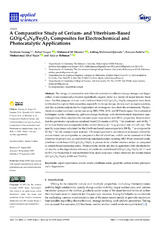Mostrar el registro sencillo del ítem
A Comparative Study of Cerium- and Ytterbium-Based GO/g-C3N4/Fe2O3 Composites for Electrochemical and Photocatalytic Applications
| dc.contributor.author | Farooq, Nosheen | |
| dc.contributor.author | Luque, Rafael | |
| dc.contributor.author | Hessien, Mahmoud M. | |
| dc.contributor.author | Qureshi, Ashfaq Mahmood | |
| dc.contributor.author | Sahiba, Farzana | |
| dc.contributor.author | Nazir, Muhammad Altaf | |
| dc.contributor.author | Rehman, Aziz ur | |
| dc.date.accessioned | 2021-10-01T11:44:41Z | |
| dc.date.available | 2021-10-01T11:44:41Z | |
| dc.date.issued | 2021 | |
| dc.identifier.uri | http://hdl.handle.net/10396/21768 | |
| dc.description.abstract | The design of sustainable and efficient materials for efficient energy storage and degradation of environmental pollutants (specifically organic dyes) is a matter of major interest these days. For this purpose, cerium- and ytterbium-based GO/g-C3N4/Fe2O3 composites have been synthesized to explore their properties, especially in charge storage devices such as supercapacitors, and also as photocatalysts for the degradation of carcinogenic dyes from the environment. Physicochemical studies have been carried out using XRD, FTIR, SEM, and BET techniques. Electrochemical techniques (cyclic voltammetry, galvanic charge discharge, and electrochemical impedance spectroscopy) have been employed to measure super-capacitance and EDLC properties. Results show that the gravimetric capacitance calculated from GCD results is 219 Fg−1 for ytterbium- and 169 Fg−1 for cerium-based nanocomposites at the current density of 1 A/g and scan rate of 2 mV/sec. The specific capacitance calculated for the ytterbium-based nanocomposite is 189 Fg−1 as compared to 125 Fg−1 for the cerium-based material. EIS results pointed to an enhanced resistance offered by cerium-based nanocomposites as compared to that of ytterbium, which can be assumed with the difference in particle size, as confirmed from structural studies including XRD. From obtained results, ytterbium oxide-based GO/g-C3N4/Fe2O3 is proven to be a better electro-catalyst as compared to cerium-based nanocomposites. Photocatalytic results are also in agreement with electrochemical results, as the degradation efficiency of ytterbium oxide-based GO/g-C3N4/Fe2O3 (67.11 and 83.50% for rhodamine B and methylene blue dyes) surpasses values observed for cerium-based GO/g-C3N4/Fe2O3 (63.08 and 70.61%). | es_ES |
| dc.format.mimetype | application/pdf | es_ES |
| dc.language.iso | eng | es_ES |
| dc.publisher | MDPI | es_ES |
| dc.rights | https://creativecommons.org/licenses/by/4.0/ | es_ES |
| dc.source | Applied Sciences 11(19), 9000 (2021) | es_ES |
| dc.subject | Super capacitance | es_ES |
| dc.subject | Cerium oxide | es_ES |
| dc.subject | Ytterbium oxide | es_ES |
| dc.subject | Graphitic carbon nitride | es_ES |
| dc.subject | Photocatalytic degradation | es_ES |
| dc.title | A Comparative Study of Cerium- and Ytterbium-Based GO/g-C3N4/Fe2O3 Composites for Electrochemical and Photocatalytic Applications | es_ES |
| dc.type | info:eu-repo/semantics/article | es_ES |
| dc.relation.publisherversion | https://doi.org/10.3390/app11199000 | es_ES |
| dc.rights.accessRights | info:eu-repo/semantics/openAccess | es_ES |

